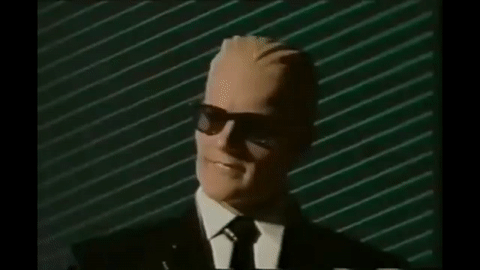MacGYVER YOUR ENTHUSIASM (1)
By:
January 2, 2025
One in a series of enthusiastic posts, contributed by 25 HILOBROW friends and regulars, analyzing and celebrating favorite TV shows from the Eighties (1984–1993). Series edited by Josh Glenn.

MAX HEADROOM | 1987–1988
Twenty minutes into the future, there is a City: full of dark corporate towers filled with conniving, callous executives, an underclass made up of desperate addicts, all scrounging for their next fix… and a small group of crusading heroes, aided by an irreverent digital entity, a ghost in the machine, who regularly hijacks the broadcast signals that keep the populace immiserated and immured in an unjust system.
You’d be forgiven for hearing the pitch for ABC’s 1987-88 series Max Headroom and considering it just another 1980s cyberpunk exploration of the hypercapitalist malaise of the late Reagan era. Max Headroom‘s origins set the stage for this little one-and-a-half season American network TV oddity.
Max started out as the project of a British duo of animation producers, Annabel Jankel and Rocky Morton, who merged their preferred mix of media — traditional animation with the nascent field of computer animation — with a live Canadian actor, Matt Frewer, made up to look like a digitally generated avatar. An hour-long TV movie was created for Channel 4, Max Headroom: 20 Minutes into the Future. Frewer plays investigative journalist Edison Carter, who stumbles upon a conspiracy by his own Network 23 and vaguely-sketched corporate giant ZikZak to stuff the airwaves full of micro-commercials called “blipverts,” so overstimulating to the nervous system that they cause especially-sedentary TV viewers to literally explode. As his own network seeks to silence him, Carter suffers a head injury (“MAX HEADROOM” on a parking garage gate is the last thing he sees) and has his consciousness digitally duplicated into the scatterbrained electronic id of Max, who becomes a troublesome living détournement of the televisual Spectacle.
ABC series re-shot this film and made it a series pilot a couple of years later, softening the edges of the more gruesome and cynical bits of the Channel 4 version, allowing for a continuing series that explored the usual array of near-future cyberpunk tropes: organ banks, digital afterlives, artificial intelligence, for-profit two-tier education, underground blood sports, the political process wholly subsumed by corporate interests, game shows where you fight for your life, the dangers of living “off-grid” in a world where citizenship is digitally constituted. For someone like me, on the cusp of adolescence when the series was in its first run, the show’s heady mix of seductively gritty visuals and cultural critique was literally like nothing else on television; someone out there was saying that TV was an addiction, just like drugs! On television!
What role does a post-Watergate crusading journalist have in a televisual world where all rebellion is inevitably recuperated into the Spectacle? In his essay on the American network television of precisely the period of Max Headroom, “E Unibus Pluram: Television and U.S. Fiction,” David Foster Wallace indicted television as “its own most profitable critic,” absolving viewers from complicity in a sea of irony and self-aware meta-references. Max’s twitchy, disconnected monologues at the ends of the first season’s episodes resemble nothing less than Rod Serling-style fourth-wall-breaking moral lessons for the postmodern age: full of sound and fury, but signifying no real change. Max himself, in his multiplicity of roles as a commercial pitchman, unctuous talk-show host, and ostensible deuteragonist of this dystopian series, is a literal avatar of TV’s ability to forgive itself and wink and nod away all concerns about whether or not all this TV is bad for you.
As the internet rose to prominence in the 1990s, Max Headroom’s specifically televisual dystopia seemed to be less and less prophetic… but with the internet’s increasing propensity to be something that is consumed rather than actively engaged with, in the internet’s ability to take the celebrities of the TV age and turn them into monstrous demagogues, it feels like Max’s world ended up being just 20 minutes into the future after all.
MacGYVER YOUR ENTHUSIASM: INTRODUCTION by Josh Glenn | Michael Grasso on MAX HEADROOM | Heather Quinlan on MYSTERY SCIENCE THEATER 3000 | Mark Kingwell on CHINA BEACH | Judith Zissman on SANTA BARBARA | Adelina Vaca on TEENAGE MUTANT NINJA TURTLES | Deborah Wassertzug on MOONLIGHTING | Josh Glenn on VOLTRON | Adam McGovern on A VERY BRITISH COUP | Alex Brook Lynn on STAR TREK: THE NEXT GENERATION | Nikhil Singh on CHOCKY | Sara Ryan on REMINGTON STEELE | Vanessa Berry on THE YOUNG ONES | Dan Reines on GET A LIFE | Susannah Breslin on PEE-WEE’S PLAYHOUSE | Marc Weidenbaum on LIQUID TELEVISION | Elina Shatkin on PERFECT STRANGERS | Lynn Peril on THE SIMPSONS | David Smay on THE DAYS AND NIGHTS OF MOLLY DODD | Annie Nocenti on THE SINGING DETECTIVE | Tom Nealon on MIAMI VICE | Anthony Miller on ST. ELSEWHERE | Gordon Dahlquist on BLACKADDER | Peggy Nelson on SEINFELD | Nicholas Rombes on TWIN PEAKS | Ramona Lyons on ÆON FLUX
JACK KIRBY PANELS | CAPTAIN KIRK SCENES | OLD-SCHOOL HIP HOP | TYPEFACES | NEW WAVE | SQUADS | PUNK | NEO-NOIR MOVIES | COMICS | SCI-FI MOVIES | SIDEKICKS | CARTOONS | TV DEATHS | COUNTRY | PROTO-PUNK | METAL | & more enthusiasms!
